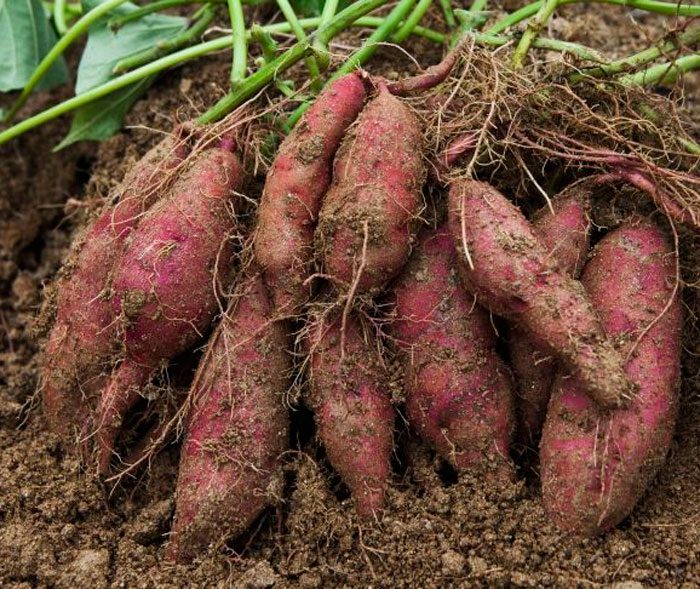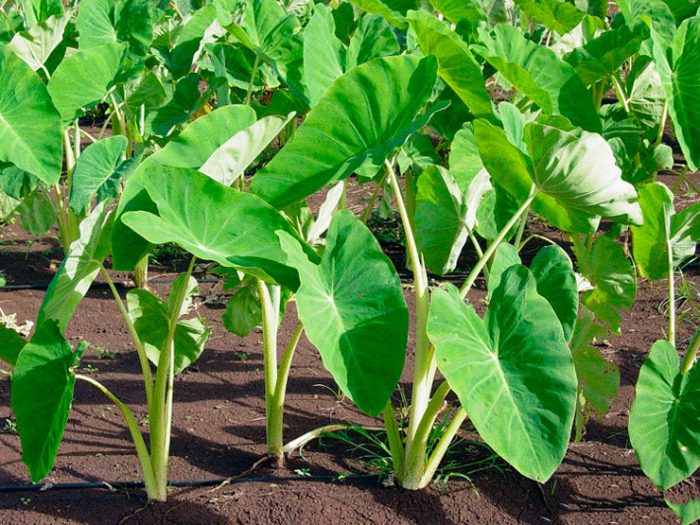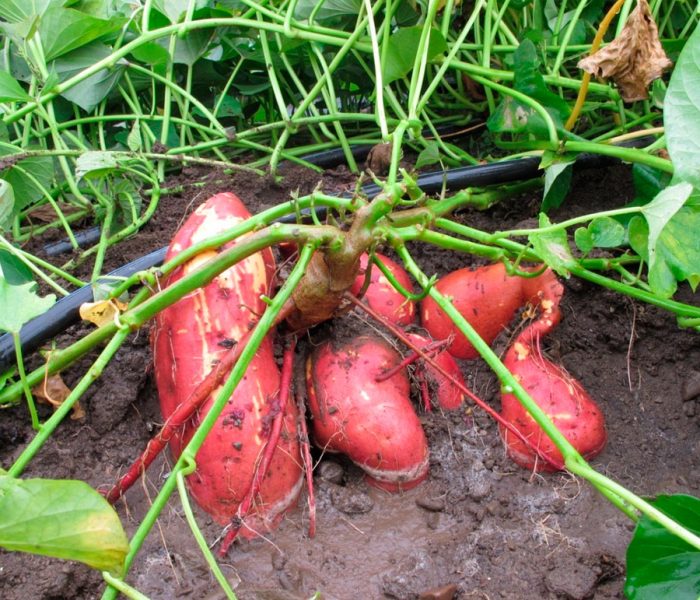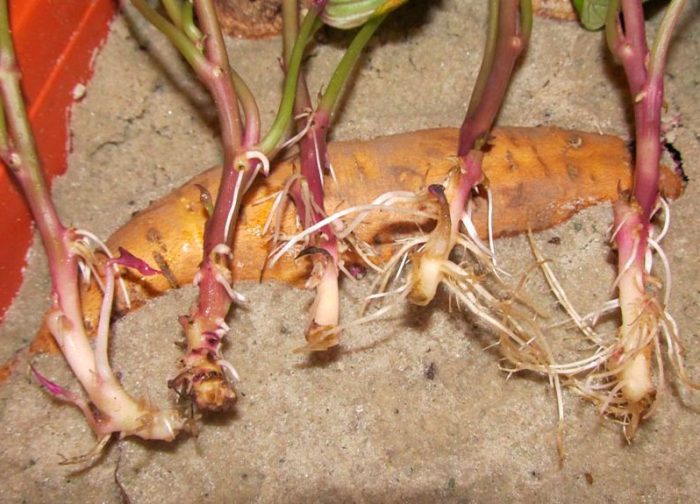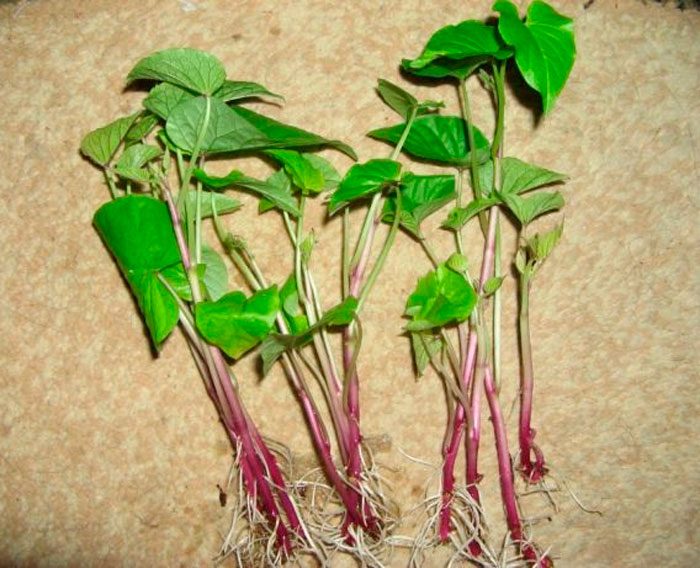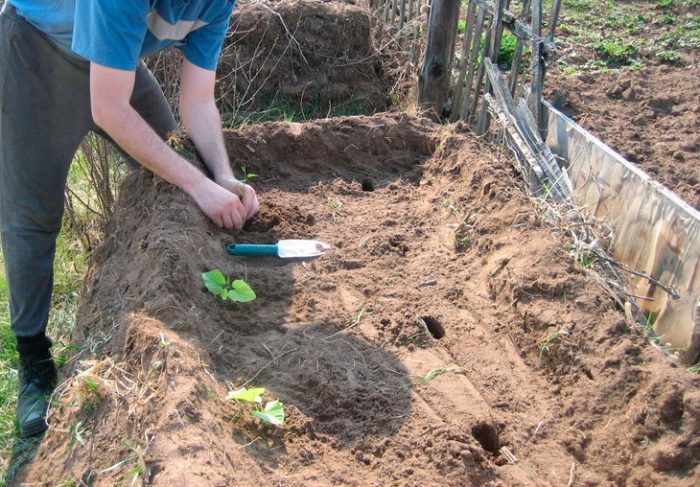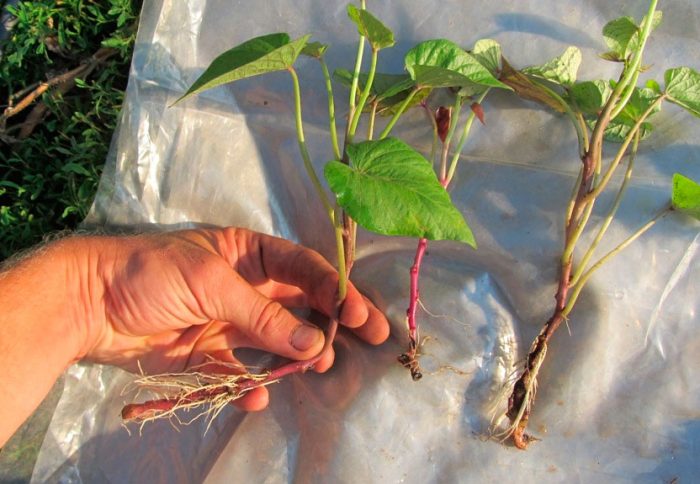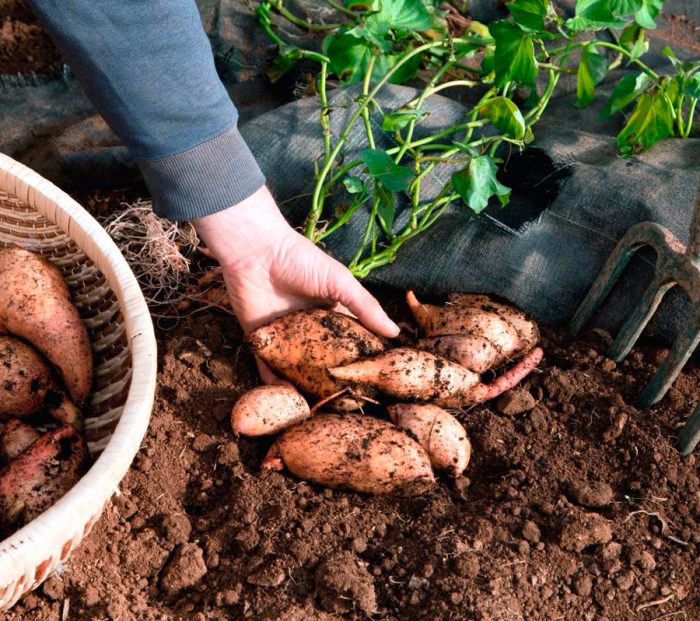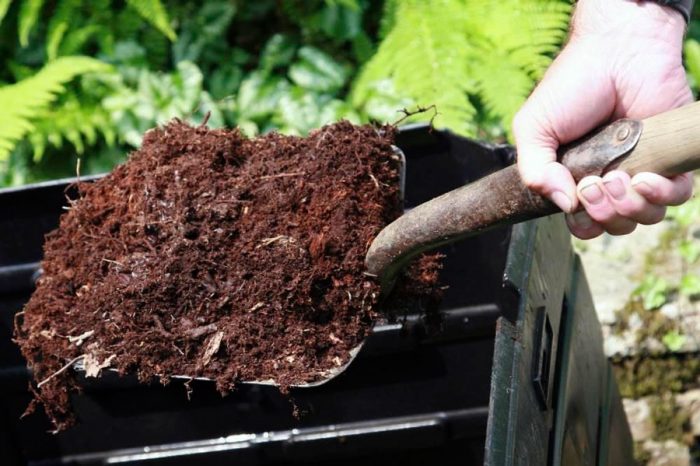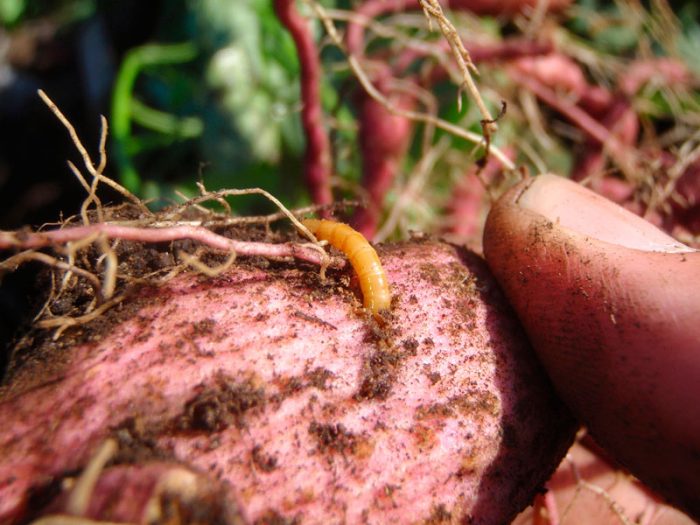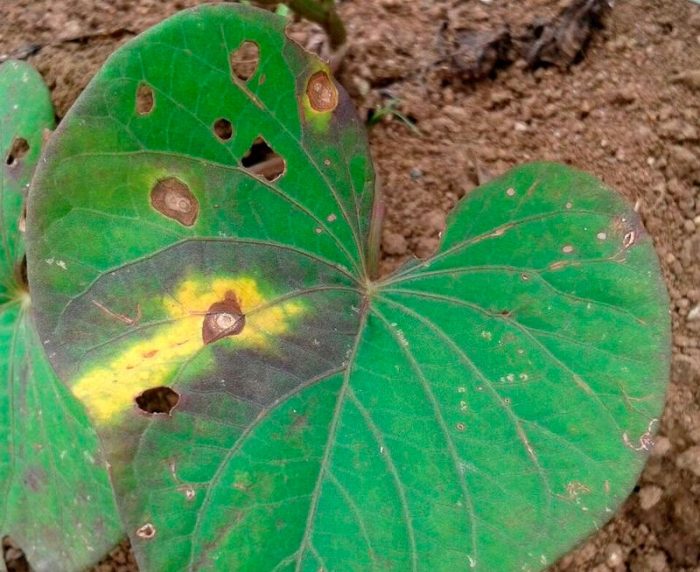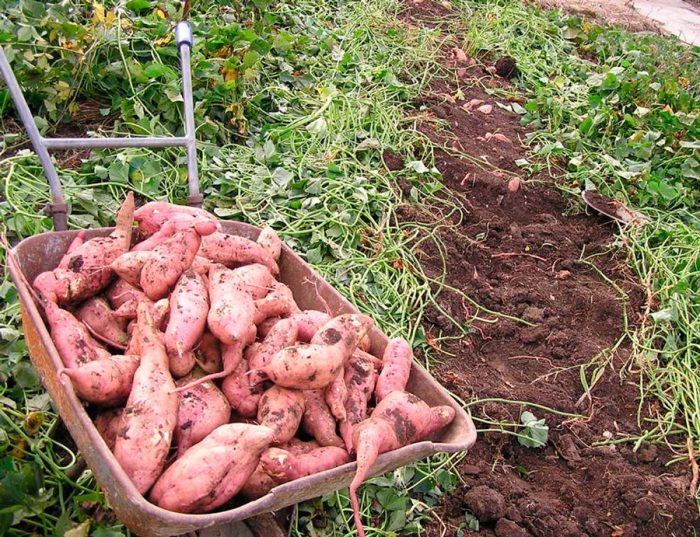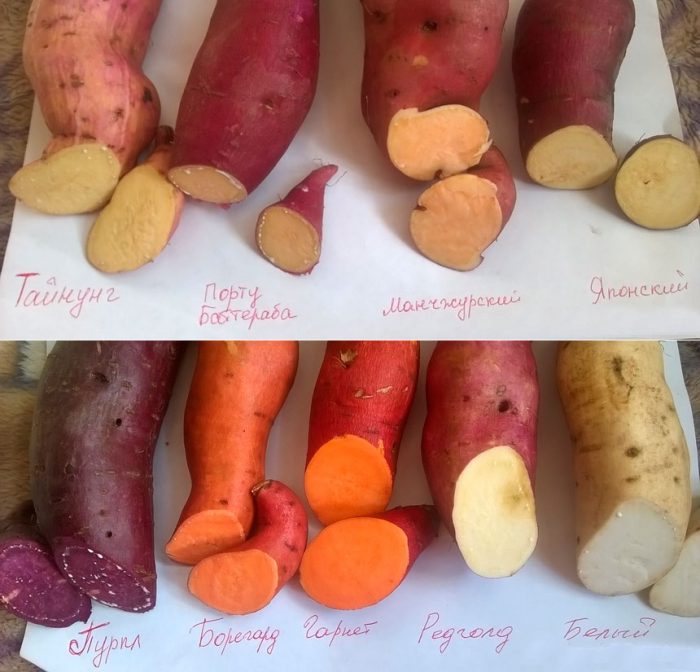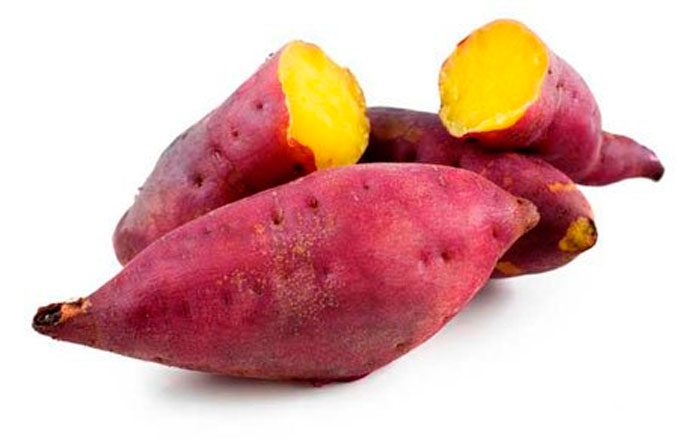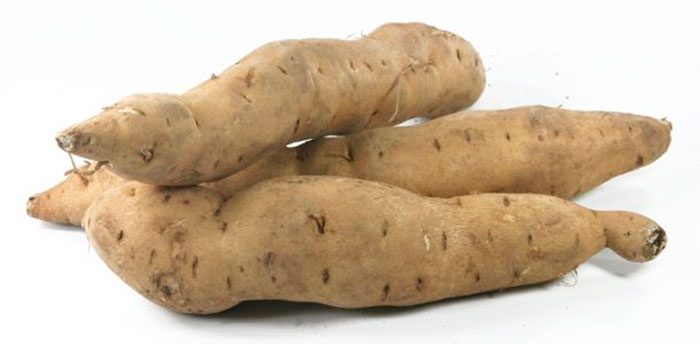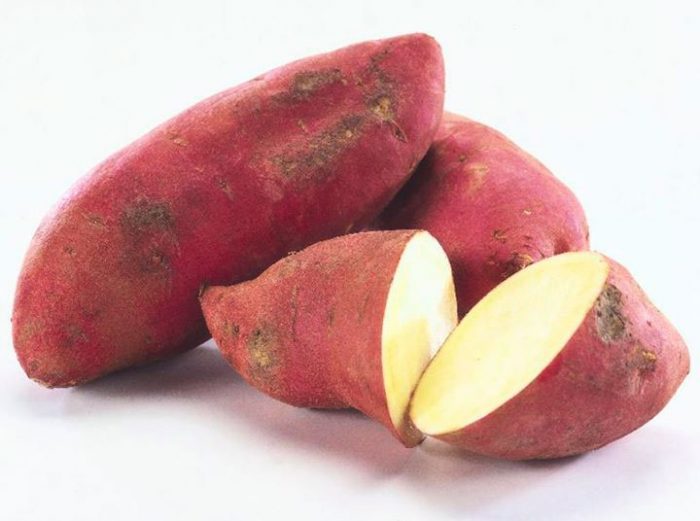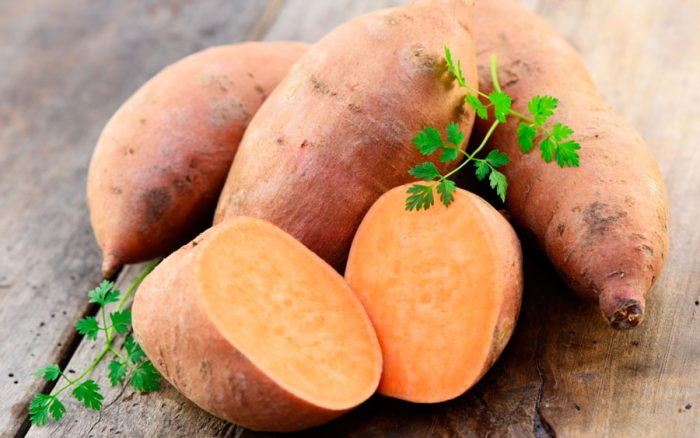Morning glory sweet potato (Ipomoea batatas), or sweet potato sweet potato is a valuable food and forage crop, which belongs to the type of tuberous plants of the genus Ipomoea of the Bindweed family. The homeland of this culture is Peru and Colombia, and from there it spread throughout South America even before the Europeans arrived there. Then the sweet potato was brought to South and East Polynesia, to Easter Island, to the West Indies and New Zealand. The edible roots of such a plant were called "kamotli" by the Aztecs; they ate them boiled, fried and raw. It was brought to the Philippine Islands by the Spaniards during the Conquest, and from there, the sweet potato came to Taiwan, the Mediterranean and Japan. To date, such a plant does not occur in the wild, but it is widely cultivated in various countries. It is grown in tropical and subtropical regions, and even in warm areas of the temperate zone, for example, sweet potatoes have been cultivated for a long time in Ukraine, while it is also found quite often in the Moscow region. In the industrial cultivation of sweet potatoes, the leading places are occupied by countries such as: Indonesia, China and India.
Content
Brief description of cultivation
- Landing... For seedlings, seeds are sown in the last days of January or in the first days of February, seedlings are planted in open soil from mid to late May.
- Illumination... Needs bright sunlight.
- Priming... Loamy or sandy loam soil, which contains a large amount of nitrogen, is excellent.
- Watering... After transplanting seedlings into open ground for the first 4 weeks, it is watered regularly and abundantly, and starting from the middle of the summer period, watering is carried out 1 time per decade, but if it rains systematically, then the plant will have enough natural precipitation. The last time the bushes need to be watered 15–20 days before harvest.
- Fertilizer... Top dressing is carried out during the formation of tubers (approximately in mid-August), the plant needs potassium, for this, a solution of wood ash should be added to the soil, for its preparation it is necessary to combine 1 bucket of water and 1-2 tbsp. ash, the mixture should be infused for 7 days, while it must be systematically stirred. To feed 1 bush, 1 liter of the mixture is poured under it.
- Reproduction... As a rule, tubers or parts thereof.
- Harmful insects... Khrushchev (May beetle larvae), slugs, spider mites and wireworms.
- Diseases... Blackleg.
- Properties... It has a high nutritional value, is considered a dietary product and has medicinal properties.
Features of sweet potato
Sweet potato is a herbaceous vine. The length of its creeping stems-lashes reaches about 500 cm, they are able to quickly take root in the nodes. The height of the bush varies from 15 to 18 meters. The lateral roots are very thickened, they form tubers, the flesh of which is edible, it can be colored orange, cream, red, yellow, white, pink or purple. The mass of tubers varies from 0.2 to 3 kilograms or more. Long-petiolate leaf plates have a heart-shaped or palmate-lobed shape. Axillary funnel-shaped flowers have a large corolla, which is painted in white, pink or light lilac. But in most varieties, when grown in the middle lane, flowering does not occur. The fruit is a box in which there are 4 seeds of black or brown color, reaching 0.35-0.45 cm in diameter.
Growing sweet potatoes from seeds
Sowing
For the propagation of sweet potatoes when grown in middle latitudes, the method of germinating tubers is used, because under these conditions flowering occurs infrequently, as a result of which the formation of seeds does not occur. Of course, you can buy seed in a specialized store, and since this plant is thermophilic, and its growing season lasts 90-180 days, you need to sow sweet potatoes for seedlings, and not in open soil. The seed of such a plant has a very high germination capacity.
Sowing for seedlings is carried out in the last days of January or the first in February. The seeds need pre-sowing preparation, for this they must be immersed in tepid water for 24 hours, then they must be disinfected in a solution of copper sulfate or manganese potassium. The processed seed needs to be dried. A soil mixture suitable for sowing should be loose and nutritious, for example, you can use a substrate consisting of turf, humus or sand (1: 1: 1). For sowing sweet potatoes for seedlings, you cannot take garden soil, because it does not contain a very large amount of nutrients, and it can also contain pathogenic microorganisms or pest eggs. The soil mixture needs disinfection, for this it is heated in a microwave oven or ignited in an oven. Sowing seeds is carried out in a moistened soil mixture, while they must be buried 15–20 mm, then its surface is slightly tamped and watered. The container must be covered with glass or film, then it is placed in a well-ventilated and well-lit place before the first seedlings appear, while the air temperature should be from 18 to 20 degrees.
Seedling growing rules
In order to grow such seedlings, it will need a certain temperature regime - from 20 to 30 degrees. Watering should be moderate but systematic. Although this plant is moisture-loving, it reacts extremely negatively to stagnant water in the root system. For irrigation, water at room temperature is used, which must settle for 24 hours. Watering is carried out only after the top layer of the soil mixture has dried out. The room where the seedlings are located should be systematically ventilated, but at the same time the plant must be protected from a draft. It is recommended to air the sweet potato immediately after it is watered. After the height of the seedlings is equal to 15 centimeters, and they have 4-5 internodes, experts advise starting their hardening, which will allow the plants to adapt to new conditions before you transplant them into open ground. For this, the seedlings are transferred to the street for some time every day for 15 days.The duration of such a procedure must be increased gradually until it can be outdoors around the clock.
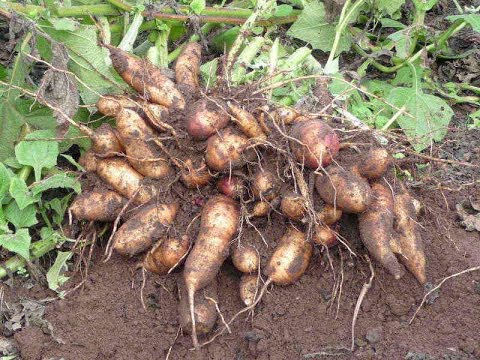

Watch this video on YouTube
Planting sweet potatoes in open ground
What time to plant
Sweet potato seedlings are transplanted into open soil only after the air temperature in the daytime is no longer below 20 degrees, while the ground should be warmed up to 15 degrees. For example, in Ukraine, especially in its southern part, seedlings are planted in open ground already in the last days of April, while in the Moscow region this procedure is often carried out in the first days of June.
An open area, well-lit by the sun and having reliable protection from strong gusts of wind, is perfect for growing such a crop. It grows best in loamy or sandy loam soil, which is characterized by low acidity, while its composition should include a large amount of nitrogen. However, sweet potatoes can also be grown on other soils.
Site preparation
Site preparation should be done in the autumn. Digging the soil is carried out to a depth of 15 to 20 centimeters, while potassium sulfate, humus and superphosphate should be added to it. The acidic soil must be limed half a month before fertilization. In spring, immediately before planting, the seedlings on the site must be loosened, while ammonium nitrate should be added to it.
Rules for planting in open soil
The depth of the planting pits should be about 15 centimeters, while the distance between them is 0.4 m, and the distance between the rows is 0.7 m.When planting long-leaved varieties, the planting holes should be made according to the 0.7x0.7 m scheme, but if the sweet potato plant more compactly, then over time it will form a carpet of foliage and shoots, which can protect the surface of the garden from rapid evaporation of moisture. The plant must be buried in the soil in such a way that the pair of internodes located at the very bottom are underground. To make the seedlings easier to transplant and take root quickly, it is recommended to cut off all the foliage from the bushes, while leaving only 1-2 pairs of the upper leaf plates. When the plant is planted in open soil, its surface should be tamped down and the bed should be well watered. Each bush should be covered with a cut plastic bottle, which should be transparent, or a glass jar. After the young foliage begins to grow in the plants, the shelter must be removed.


Watch this video on YouTube
Sweet potato care
Both an experienced gardener and a beginner can grow a sweet potato on their site. Most importantly, one must remember that the planting or seed material must be of high quality, and the plants must also be properly looked after and adhere to the agrotechnical rules of this culture. Also, do not forget that this plant is distinguished by its thermophilicity. There is nothing difficult in caring for sweet potatoes: if necessary, planting should be sheltered from the cold, water them in time, weed, feed, protect from harmful insects and diseases, and also loosen the surface of the beds.
When growing such a culture, it must be remembered that its lashes in no case should take root in internodes, in this regard, it is necessary to systematically raise each shoot in order for the resulting roots to break off. In order for the tubers to be larger, in the twentieth of August, it is necessary to make a mandatory pinching of the upper part of each lash.
How to water
This plant is drought tolerant, so it does not need to be watered abundantly. However, in the first 4 weeks after transplanting seedlings into open soil, watering should be systematic and abundant, after which it is reduced to moderate. From the middle of summer, the garden is watered no more than 1 time in 1.5 weeks, but if it rains regularly at this time, then natural precipitation will be enough for the bushes. When 15–20 days are left before harvesting, you must stop watering the sweet potato.
Top dressing of sweet potato
During the formation and growth of tubers, sweet potatoes are especially in need of feeding, for which potash fertilizer is used. Typically, this time falls in mid-August. For feeding, an infusion of wood ash is excellent; in order to prepare it, you need to combine 1 bucket of water and 1-2 tbsp. wood ash, the infusion will be ready after 7 days, while you must not forget to stir it periodically. To feed one bush, 1 liter of the nutrient mixture is poured under it.
Sweet potato pests and diseases
Harmful insects
The sweet potato is distinguished by a fairly high resistance to various harmful insects and diseases that are common in middle latitudes. However, beetle larvae can harm it, while it is noticed that they, as a rule, damage the largest and most beautiful tubers. It is imperative to fight the beetles and their larvae, and you can use various methods.
During long rains, slugs can settle on the bushes. In order to get rid of them, bait is used; for this, bowls filled with beer must be placed on the site in several places. They should be systematically checked and collected from the gastropods crawling into the flavor of the bait. Also, the bushes can be protected by digging a not very deep groove around the garden bed, which must be filled with fine screenings, it will become an insurmountable obstacle for such a pest.
Spider mites can also settle on the bushes, as a rule, this occurs during a prolonged drought. To get rid of such a pest, plants are sprayed with infusion of hogweed, onion husks, henbane, dope or chamomile.
Diseases
During the seedling period, the bushes can be hit by a black leg. In affected plants, the stem rotting at the root collar occurs, and this leads to their death. For prophylaxis, for sowing seeds, it is necessary to use a disinfected substrate, for this it is spilled with a solution of Fitosporin-M, and in order to avoid acidification, eggshells are introduced into it, which must first be ground into flour.
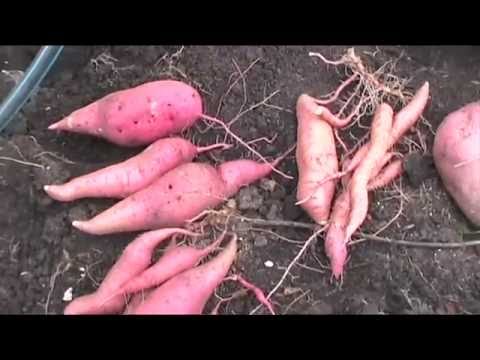

Watch this video on YouTube
Cleaning and storage of sweet potatoes
The sweet potato harvest begins 14–16 weeks after the seedlings are transplanted into open soil, usually in mid-September. Do not forget that the harvest must have time to be harvested before the onset of frost, and for this you should choose a fine and dry day. At this time, yellowing and drying of foliage and shoots should begin. If the tubers were dug up in damp weather, they cannot be stored, in this regard, they must be processed, the same must be done with injured root crops. A pitchfork is used to extract tubers from the soil, then they must be left on the surface of the site for a while so that they can dry well. It is necessary to dig them out of the soil very carefully, since their length can reach up to 0.3 m.When the roots dry out, the remains of the soil must be removed from their surface, and then they must be sorted. Healthy and whole tubers are suitable for storage, while all injured and in doubt must be sent for processing. Those root vegetables that are suitable for storage should be placed in a warm place for 7 days (from 28 to 30 degrees), while the air humidity should be 85-90 percent, do not forget to systematically ventilate the room. After that, the tubers are placed in not very deep trays and stored in a cool room (from 10 to 15 degrees), where they will be stored for several months.
Sweet potatoes can be stored frozen by cutting them into slices and then fried until half cooked. Then they are placed in containers or bags, then they are tightly closed and put into the freezer. Also, this root vegetable can be stored in dried form, for this it is thoroughly washed, peeled and cut into strips or thin slices.They must be washed with running water and blanched in boiling water for five minutes, after which they are sharply cooled by immersion in water. When the water drains, the sweet potatoes are laid out on a baking sheet in 1 layer and placed to dry in an oven heated to 80 degrees, while it must be systematically stirred. When the roots are thoroughly dry, you need to wait until they completely cool naturally, then they are poured into bags or paper bags for storage.
Also tubers can be used for preservation. They are cut into cubes and boiled until half cooked in water, which needs to be salted and spices added, then they are laid out in sterilized jars with a volume of 0.5, boiling water is poured into them and half a teaspoon of vinegar is added to each, then they are rolled up and removed under a fur coat until it cools completely. Completely cooled cans are removed for storage.


Watch this video on YouTube
Types and varieties of sweet potatoes
The sweet potato has no official varietal classification; there are about 7 thousand total hybrids and varieties of such a plant. In China alone, about 100 varieties of sweet potatoes are cultivated. All varieties are divided into vegetable, fodder and dessert. They are also distinguished by the color of the pulp, by the color of the peel and by the shape of the root crop. They also distinguish such characteristics as: the shape and color of the foliage, yield, as well as the accuracy of the formation of tubers. Still, all varieties are divided into early ripening, mid-ripening and late-ripening according to the ripening period.
Dessert sweet potato
These varieties contain large amounts of glucose and beta-carotene. The color of the flesh of the tubers is orange or rich yellow, and their taste is sweet. Such varieties are light-loving and thermophilic, therefore, in conditions of middle latitudes, they grow rather poorly, the subtropics and tropics are best suited for them. The taste of the tubers depends on the variety and can be similar to pumpkin, banana, pineapple, chestnut or carrot. They go well with nuts, molasses, fruits and caramel, and therefore this sweet potato is most often used in the preparation of casseroles, sweet cereals and other desserts. Most popular varieties:
- Kumara Red... This hybrid is distinguished by its demanding temperature and illumination. Large bushes have thick leaves and long whips. The shape of the roots is oblong-rounded, the taste of the pale yellow pulp is moderately sweet. The taste of raw pulp has a slight astringency.
- Beauregard... It is very easy to care for such a plant. The very tasty and sweet tubers contain a large amount of carotene and glucose. The bushes are compact, the roots grow even copper-colored. The color of the pulp is orange.
- O.Henry... This is a variety of the American Boregrad variety, which is highly resistant to harmful insects and diseases. The color of the tubers is pale cream, the sweetish light yellow pulp has a dry consistency.
- Garnet... This mid-early variety of American selection has an average yield. The tubers are pale red, the sweet pulp has an orange color.
- Victory 100... This early ripening variety with high yields grows well in mid-latitude conditions. The bush is compact, and the roots are even and smooth. The orange flesh has a moderately sweet taste similar to bananas and nuts, but these characteristics appear only after the tubers lie down a little after being removed from the soil, and they are tasteless at first.
- Georgia Red... Such a productive variety grows well in mid-latitudes. The compact bush is decorated with dark red foliage. The color of rounded root crops is copper-orange. Light pulp while raw has a taste very similar to potatoes, but after heat treatment it becomes soft and sweet.
- Burgundy... This early ripe American variety is resistant to fusarium. The dark red tubers have a very pleasant smell and are rich in sucrose. The color of the dark orange pulp does not change even after heat treatment.
Fodder yam
The composition of tubers of these varieties contains less sugar compared to vegetable or dessert. These varieties can be an excellent substitute for potatoes. As a rule, the pulp of the tubers has a light color; after heat treatment, it becomes soft. Such root vegetables can be fried. These varieties grow well both in southern regions and in mid-latitude conditions. Most popular varieties:
- White bouquet... This variety has a high yield. Powerful bushes have long lashes. The mass of large cream-colored root crops in some cases can reach from 3 to 4 kilograms. The white flesh tastes like chestnut.
- Brazilian... Such a hybrid grows well in mid-latitudes, it is resistant to diseases and harmful insects, and has a high yield. Light colored roots have white flesh with a mild taste.
Vegetable sweet potato
The composition of tubers of vegetable varieties contains less glucose compared to dessert ones, but it is more than in fodder varieties. In this regard, the root crops have a taste similar to frozen potato tubers. Their pulp is light in color with splashes of yellow, orange or pink. After heat treatment, it becomes soft, tender and juicy. However, in most varieties, root vegetables are not suitable for frying, since they are somewhat watery, but they make a very tasty puree. Most popular varieties:
- Purple... An early ripe variety with high yield and resistance to harmful insects and diseases. This sweet potato is superior to potatoes in nutritional and taste qualities. The powerful bush has dark green foliage and long whips. The purple color of the root crops remains even after heat treatment. The pulp is practically unsweetened and has a chestnut flavor.
- White sweet potato... The tubers of this variety have a texture and taste very similar to potatoes. This sweet potato grows well in mid-latitudes and has a fairly high yield. The shape of light root crops is oblong, their flesh is white.
- Japanese... This variety is early maturing. In red root vegetables, the flesh has a pale cream color. Compared to varieties with an orange heart, the pulp is less sweet and drier. Such tubers can be a substitute for regular potatoes.
- BIT-1... This Italian variety is late. White roots have a slightly sweet pulp of the same color.
- Bonita... This early-ripening variety is starchy and slightly sweet, it has a high yield and resistance to fusarium. Pinkish-cream tubers have white flesh with a cream shade.
- Bushbuck... The homeland of this variety is South Africa. The color of the tubers is raspberry pink, during storage it becomes darker. The slightly sweet, creamy white flesh tastes very similar to potatoes.
- Vinnytsia pink... This Ukrainian variety has a high yield. Bushes are tall. The color of smooth root crops is pink, they are distinguished by excellent keeping quality. Light, almost unsweetened pulp while raw has a taste similar to cabbage stalk. This sweet potato is sometimes found on sale under the name Redgold, Gocha and Tekken, since it looks very similar to these varieties.
- Sumor... Such an early ripe variety is distinguished by its yield and resistance to harmful insects and diseases. The color of the root crops is creamy, the pulp is light and unsweetened, its taste is identical to that of potatoes.
In addition to the varieties described, the following are very popular among gardeners: Tynung, Hannah Gold, Har Bay, Betty, Burgundy, Belvo, Baker, Butterbach white, red and pink, White Delight, Virginia, Delaware purple, Golden Bell, Derby, Jersey yellow and orange, Ginseng red, Indian, Carver, etc.
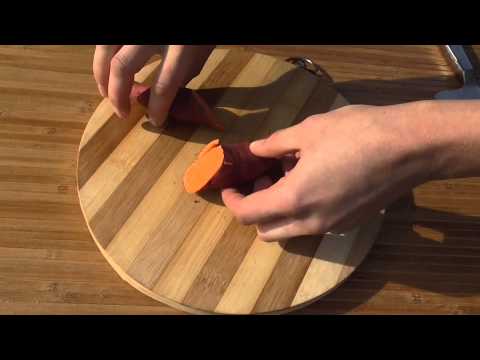

Watch this video on YouTube
Sweet potato properties: harm and benefit
Useful properties of sweet potato
The sweet potato tuber contains a fairly large amount of sugar and starch, but at the same time it is quite low in calories.They include proteins, carbohydrates, calcium, magnesium, potassium, phosphorus, iron, choline, thiamine, riboflavin, pantothenic acid, vitamins A, C, PP.
The starch of such a plant has found wide application in official medicine. So, it is used during the treatment of various diseases of the gastrointestinal tract, while it has a softening, restorative and enveloping effect, it also contains a large amount of vitamins. Roots contain vitamin B6 (pyridoxine), which helps to strengthen the walls of blood vessels, which is why it is recommended for people suffering from cardiovascular diseases to include sweet potato dishes in their diet.
Compared to other vegetables, sweet potatoes contain much more ascorbic acid, which protects the body from the effects of free radicals, which cause cellular corrosion that contributes to the development of cancer. This vegetable is recommended for women during menopause, as it contains progesterone. Since the fiber in tubers is much more tender than that of other vegetables, it is recommended to include them in the diet for people who suffer from digestive disorders. Such root vegetables, fried and boiled, have a sweetish taste similar to frozen potatoes, but they contain much more carbohydrates and calcium than potato tubers.


Watch this video on YouTube
Contraindications
Experts do not recommend eating sweet potatoes for people suffering from gastritis, as well as duodenal and stomach ulcers, as it irritates the mucous membrane. It is also recommended to exclude it from the diet of women during pregnancy and breastfeeding. Also, it cannot be eaten by people with individual intolerance.

